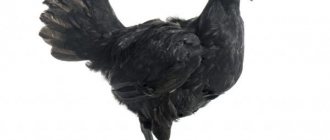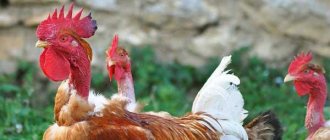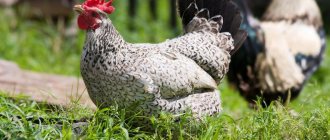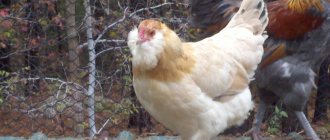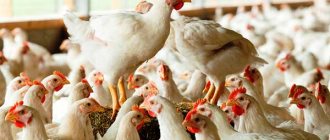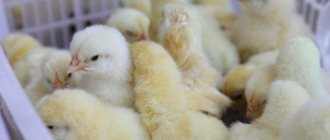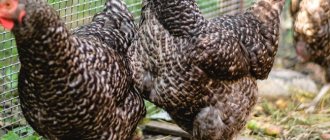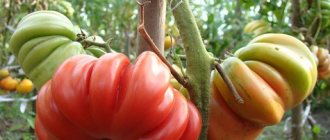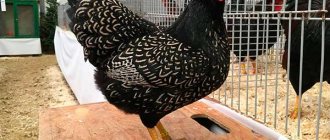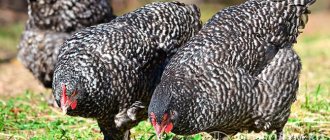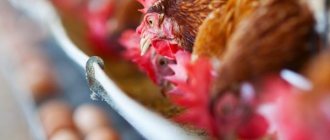History of the breed
Together with other popular breeds of mini-chickens, which are now widespread in Europe, the B-66 was bred at the All-Russian Research Veterinary Institute of Poultry Farming. There are three main colors of representatives of this breed: fawn, white and red-black.
Did you know? Contrary to popular belief that chicken brains are underdeveloped, a one-day-old chick exhibits the same skills and reflexes as a three-year-old child. Moreover, despite the simple structure of the chicken’s brain, these birds are able to distinguish the owner from other people, remember about a hundred faces, easily learn new skills and have excellent time orientation, clearly knowing when the next feeding time will come.
All of them are carriers of the dwarfism gene, isolated through selection and careful breeding from breeds such as Plymouth Rock, Leghorn, Cornish and Rhode Island. The purpose of creating such chickens was to solve economic problems in rural farms.
How to breed the breed?
If in the future the farmer wants to sell eggs for incubation or chickens, then special attention should be given to breeding individuals. After two months of life, it is necessary to select the strongest cockerels and hens that best meet the stated breed standards. It is strictly forbidden to allow the addition of other blood, because in the future new individuals will not be able to pass on their qualities.
The declared breed has only a white color, but it can be changed or diluted by crossing individuals of the “Vnitip” line with p 11, b 77, b 33, and so on. It is necessary to add a purebred cockerel of a different color, and as a result you can get a fawn, striped or red color.
When crossing, adding fresh blood is not recommended. Due to this, birds' immunity can be significantly reduced and hereditary traits can subsequently be lost.
These chickens are also used to produce high productivity broilers. Females are mated with meat-producing roosters, such as the Cornish breed.
Mini chickens develop and grow very well. They also love warmth, so for the first days after birth, they need to be kept under lamps. In order for the survival rate to be high, it is necessary to organize good feeding, cleanliness, as well as inspect the young animals and remove weak or sick individuals in a timely manner. It is also necessary to prevent overcrowding of the young, because of this reason, chickens mainly die.
Description and distinctive features
In countries such as the UK and France, mini-chickens have already completely replaced broilers, not only because of their external distinctive features, but also their calm nature and well-developed maternal instinct.
We recommend that you familiarize yourself with such meat breeds of chickens as Brahma, Mechelen Cuckoo, La Fleche, Langshan, Jersey Giant, Dorking, Cochin, Orpington and Faverolles.
External features
The body of such chickens, despite their compactness, is quite dense and fleshy, with thick plumage, a wide back and a rounded chest. On the head of a standard size there is a small leaf-shaped crest and small ears.
Video: description of the B-66 chicken breed The paws are short, with a shortened metatarsus (it is 30% smaller than in other meat breeds). The neck is quite wide. The wings are not very well developed and fit tightly to the body.
Temperament
As for the behavior of such chickens, they, unlike other breeds of meat poultry, are quite calm, do not fight with neighbors, with the exception of rare skirmishes between roosters, and, most importantly for farmers, do not dig holes.
Hatching instinct
The incubation instinct of the breed in question is quite well developed, so there is absolutely no need to force hens to sit on eggs. Their desire to hatch eggs appears in the spring, when the period of active egg production begins. Hatching duration is from 21 to 24 days.
Productivity
Despite the fact that chickens of the B-66 breed are miniature, they have excellent dynamics and growth intensity. With fairly rapid puberty, they have excellent egg production.
Intensity and dynamics of growth
Chickens of this breed grow very quickly:
- by the age of 2 months, cockerels weigh about 1 kg, and hens - 800–850 g;
- at the age of 3 months, males already weigh about 1.7 kg, and females - about 1.5 kg;
Important! It is at the age of 3 months that it is worth removing from the herd those individuals that have any deviations in weight, size or appearance.
- if you keep chickens in proper conditions and give them enough food, after 4 months the cockerels will weigh up to 2.5 kg, and the hens will weigh up to 2 kg;
- at a very mature age, the weight of cockerels can be about 3 kg, and hens - 2.7 kg.
Puberty and egg production
Puberty in individuals occurs at the age of 3 to 6 months. The egg production of this breed is universal; one individual per year can lay 180 eggs, each of which weighs from 50 to 60 g.
Meat and egg breeds
This breed is a type of mini chicken. In 66, like other lines of mini chickens, they were created in Russia at the Zagorsk Institute of Poultry Science. Such chickens have not yet gained great popularity in rural farms, but they have very active dynamics, and are also famous for only positive reviews.
Keeping mini chickens is a very profitable business. They eat little and yet show high productivity. Many modern farmers want birds that combine two main qualities. This is high-quality and tasty meat, as well as high egg production. The B66 breed copes well with these two areas.
Features of this bird:
- relatively low live weight (♂2.7-3.1; ♀2.5-2.8)
- shortened metatarsus (20-23%)
- compact build, calm disposition
- good digestibility of feed nutrients
- egg production for 64 weeks of life - 165-170 eggs (at the end of the productive period - more than 40%)
- sexual maturity - 24 weeks
- peak egg production - 82%
- egg weight at 26 weeks - 53-54 g, at 52 weeks - 64-66 g
- yield of breeding eggs - 90-92%
- chick hatching - 81-83%
- safety of young animals - 96%, mortality + culling of chickens -13%
- feed costs for 10 eggs - 2.1-2.2 kg
The compact build and low live weight of meat “mini” chickens makes it possible to increase stocking density by 40%. This bird can be raised and kept in cages or outdoors.
Two paternal lines of meat chickens - carriers of the dwarfism gene of the VNITIP selection - have colored plumage: the red white-tail type - line B77, and the A77 line of the Rhode Island red type).
By crossing paternal line roosters (B77 and A77) with maternal line hens (B66, BK66), it is possible to obtain two-line combinations of meat mini-chickens with a wide range of plumage colors: from fawn to red-black. Farmers and amateur poultry farmers receive meat and eggs with minimal input of feed and energy.
Firstly, Mini-chickens are domestic breeding developments, so the bird is included in the conservation program - everything will be fine with it. There is no need to use new sires - you just need to breed offspring from different roosters, recording the pedigree. This way you can avoid inbreeding for quite a long time.
Secondly, VNITIP mini-meat and mini-egg chickens are protected by a patent, this is considered state approval of a selection achievement.
Description of the breed on the Gene Fund website (Sergiev Posad)
The purpose of creating this breed was to reduce the cost of maintaining a parent flock of meat chickens due to increased stocking density and reduced feed consumption, which was successfully implemented by VNITIP employees in the 80s of the last century. As a result of using this technology for maintaining the parent flock of meat poultry, the cost of day-old meat chickens compared to industrial broilers can be reduced by up to 15%.
The live weight of hens and roosters under the influence of the dwarfism gene “dw” is reduced by 27–35%, compared with poultry of maternal forms of industrial crosses with normal body weight, and feed savings when raising young animals and keeping adult birds reaches 25–27% .
This bird can be kept as a meat and egg bird, and with the appropriate type of feeding, as a meat bird.
Features of this bird:
- – relatively low live weight (hens 2.7–3.1; roosters 2.5–2.8);
- – shortened metatarsus (by 20–23%);
- – compact build, calm disposition;
- – good digestibility of feed nutrients;
- – egg production during 64 weeks of life –
- 165–170 eggs (at the end of the productive period - more than 40%);
- – sexual maturity – 24 weeks;
- – peak egg production – 82%;
- – egg weight at 26 weeks – 53–54 g, at 52 weeks – 64–66 g;
- – yield of breeding eggs – 90–92%;
- – chick hatching – 81–83%;
- – safety of young animals – 96%, mortality + culling of chickens – 13%;
- – feed costs for 10 eggs – 2.1–2.2 kg;
- – feed costs per 1 kg. weight gain – 1.78 kg;
- – age of reaching slaughter weight of 2 kg – 75 days.
This bird can be raised and kept in cages and on the floor.
In Russia (at VNITIP), 2 lines of chickens were created - carriers of the dwarfism gene: B66 (a bird with white plumage), B77 (a bird with fawn plumage) and a combination of B76, which are included in the State Register of Breeding Achievements.
Article about Mini chickens from E. Ustinov, A. Egorov
Chickens of highly specialized breeds, that is, either eggs or meat, are less interesting for homestead farms.
The population is more willing to raise poultry, from which they can get both eggs and meat. These include meat mini-chickens.
They are unpretentious, quiet, small-sized, good layers, their eggs are large, and their meat is tasty. In industrial conditions, each mini pullet saves 4-6 kg of feed compared to regular meat chickens, and 600-800 g of feed is saved for every ten eggs. Only 120-130 g of feed is consumed per bird per day. Not to mention the fact that such babies also need smaller living space.
Mini-chickens are very popular in France and England, where they have replaced most of the broiler parent flock. They are also bred in other countries. At our institute, two populations of meat mini-chickens with white and fawn plumage were created. Later, a third appeared - with a red and black color, like the Rhode Islands. Having acquired white mini-chickens and a red-black rooster, you can get colorful offspring from them: white, striped, smoky, calico, gray-black, red, red-white, red-black and even black chickens. In a word, you will have a wide field for creativity, to try your hand as a breeder.
What kind of bird is this? Like all meat chickens, it has a compact body, only its legs are shorter and it weighs less: roosters up to 3 kg, chickens - from 2.5 to 2.7 kg. The plumage is dense, the crest is leaf-shaped and small, so it does not get frostbite in winter.
They lay up to 180 eggs per year, weighing an average of 60 g. The shells of the eggs are strong, with a color ranging from cream to brown. If someone wants to get early maturing chickens (broilers) from babies, they need to temporarily replace the mini-rooster in the flock with a regular one of the Cornish breed.
After two weeks, the eggs can be collected and incubated. The meat of these crossbreeds is more tender and more flavorful. It is not advisable to breed mini-chickens “inside” for more than two years. Hobbyist poultry farmers who leave birds for breeding must carry out very careful selection, trying to achieve an accurate standard for chickens of this type. It is not advisable for mini chickens to receive blood from other breeds. This weakens and greatly changes their hereditary qualities, so that ultimately the “mini” type may be lost. Chicks can be hatched in an incubator or under a brood hen.
Egg fertilization is high - 93-95%, and hatchability - from 80 to 88%. The chickens are growing well. At 8 weeks of age, cockerels weigh 900-1000 g, hens - 800-850 g.
The first time the bird is assessed is at 2.5-3 months of age, when the cockerels weigh 1600-1700 g, the hens weigh 1400-1500 g. This time, weak, underdeveloped young animals and most of the cockerels are removed from the herd. The sex of the bird can be determined by the more developed comb in males; they also have braids of the mane and lower back. The second time the young are selected at 4-5 months. There are 8-10 hens per rooster.
Cockerels at this age weigh 2.4-2.5 kg, hens - over 2 kg.
Chickens, like all young birds, love warmth. The cold in the first days is destructive for them. They do not approach the food, weaken and die. In good conditions, almost all are viable and preserved. In the first days, young animals are kept at a temperature of 34-36°, and then every week they reduce it by 2-3°. At two and a half weeks, the chickens no longer need to be heated - they will not freeze even at a temperature of 18-20°. They are fed the same as all chickens.
Author: E. Ustinova, A. Egorova, Candidate of Agricultural Sciences
Feeding ration
The B-66 breed of chickens is unpretentious in terms of feeding, but you need to know what differences there are in the diet of adults, which are raised to lay eggs, and young representatives of the breed, left for meat.
Important! To avoid unwanted mutations in the herd, it is necessary to update it with unrelated individuals from time to time.
Adult herd
Individuals raised for hatching eggs are best fed with mixed feed at a young age (120–130 g per day per individual), and then gradually transferred to crushed grain mixtures with the obligatory use of grass, wet food, meat-and-bone meal and other additives.
Young animals
To get good chicken meat in a short time, it is important not to skimp on feed, but to use a high-quality industrial product with a high content of amino acids, vitamins and minerals, which are so necessary for growing birds.
Find out how to make feed for laying hens at home, what is the amount of feed for laying hens per day; how to give chickens bran, grass, live food, meat and bone meal, fish oil, yeast, and whether it is possible to give chickens bread, salt, garlic and polystyrene foam.
Correct content is the key to success!
No poultry will show good productivity if it is kept in poor conditions and fed incorrectly. Also, for mini chickens, you must follow several rules of care. The first thing is the cleanliness of the chicken coop. It is necessary to regularly remove droppings and wash feeders and drinking bowls daily. If wet food is given, which is typical for breeding at home, then feed should be provided as much as the chickens can eat at one time. Because mash oxidizes quickly. There should be no drafts in the room. The normal temperature for keeping is 18-25 degrees. Cleanliness is very important for mini chickens. If the owner takes good care of his livestock, he avoids many intestinal diseases, parasites and other ailments. Basically, all diseases of chickens appear due to unsanitary conditions and a poor diet.
When keeping cells in cages, it is necessary to treat the cells with special antiseptic solutions, and cleaning must be done more often than with floor breeding. When feeding, it is best to focus on compound feed, which is intended for meat birds.
Content Features
Proper maintenance is the key to the health and productivity of chickens, the quality of their eggs and meat. Therefore, it is important to know how to properly care for the poultry house or cages in which birds live, as well as to maintain conditions for their comfortable living.
In the poultry house
Keeping birds in a chicken coop requires compliance with certain rules:
- The poultry house for such chickens may not be very large, since its inhabitants themselves are not large in size.
It does not need to be equipped with heating devices, because this breed adapts well to any climatic conditions.
However, in the first days of life, the chicks should be provided with warmth, since the cold can kill them. Read more about how to build a chicken coop, how to make lighting, heating, ventilation in it, how to build a run for chickens.Initially, chickens need a temperature of +35 °C, then every week it must be lowered by 2 degrees, gradually bringing it to +18–20 °C.
- For the winter, the poultry house must be equipped with additional lighting, since due to the lack of the required amount of light, the chickens may stop laying eggs.
- The chicken coop must have good ventilation and no drafts.
- Bedding can be made from straw, hay or sawdust. It should absorb excess moisture, thereby protecting the inhabitants of the poultry house from parasites and infections. It is important to ensure that the litter is clean and dry and turn it regularly so that the material does not cake. As it gets dirty, you should add a new layer on top of the dirty one or clean out the previous one, replacing it with a new one.
- The chicken coop must have nests, which are best placed at a height of half a meter.
- It is necessary to ensure that there are drinkers and feeders in the poultry house: it is better to place them on a small hill. Feeders should have sides to prevent food from spilling out.
- Several times a year it is necessary to carry out a general cleaning of the chicken coop.
Did you know? Roosters are needed not only for reproduction, they perform other important functions in the chicken coop: they call chickens to eat, protect them from small predators, wake up birds (and not only) in the morning, invite them into the chicken coop or cage after walks.
In cells
Individuals raised for meat production are best kept in cages. Mandatory procedures for caring for cages are almost no different from what needs to be done to maintain cleanliness in the poultry house: you should disinfect the cages with antiseptic solutions, regularly change the litter, carry out general cleaning, etc.
However, in the case of cages, this must be done much more often than in poultry houses. At the same time, we should not forget that birds need walks in the fresh air, where they can get the necessary vitamins, so it is important, especially in the warm season, to regularly let chickens out for a walk.
We recommend reading about the pros and cons of keeping chickens in cages, as well as how to make a chicken cage with your own hands.
